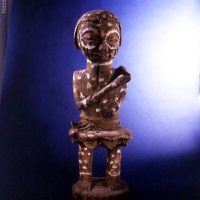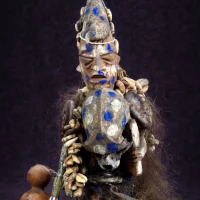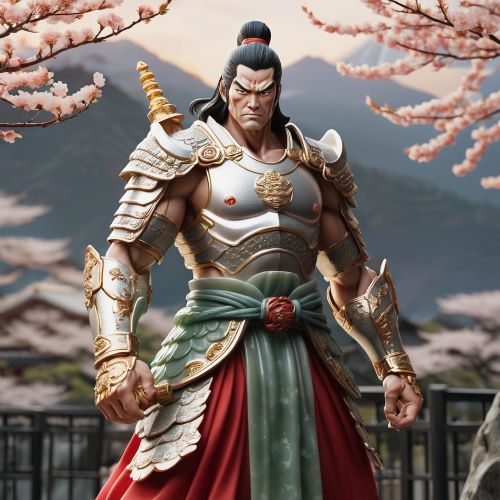Kichijoten : Goddess of Fortune
Listen
At a glance
| Description | |
|---|---|
| Origin | Japanese Mythology |
| Classification | Gods |
| Family Members | Bishamonten (Father), Benzaiten (Mother) |
| Region | Japan |
| Associated With | Prosperity, Wealth, Abundance, Good Fortune |
Kichijoten
Introduction
Kichijoten, revered in Japanese mythology, is also known as Kisshoutennyo or Kudokuten. She is a Buddhist adaptation of the Hindu goddess Lakshmi, embodying beauty, charm, and symbolizing good fortune and abundance. With grace and elegance, Kichijoten stands out in Japanese folklore, weaving her presence through tales of prosperity and happiness. Her radiant figure epitomizes beauty, happiness, and prosperity, blending elements of Buddhism and Hinduism to solidify her revered status in Japanese culture.
Physical Traits
Kichijoten, often depicted as a noblewoman, dons attire reflecting the artist’s vision, exuding an incomprehensible beauty that leaves onlookers in awe of her grace. Adorned with a Nyoihōju gem, symbolizing her ability to grant good luck, she embodies the epitome of beauty in Japanese mythology. Her luminous skin and flowing robes, often embellished with symbols of abundance like ripe fruits and flowers, underscore her role as a harbinger of prosperity. Renowned for her breathtaking beauty, she radiates elegance with flowing dark hair and fair skin, whether adorned as a noblewoman or a Chinese court lady. The Nyoihoju, a wish-fulfilling jewel, symbolizes her power to grant desires, accentuating her association with wealth and abundance.
Family
In Japanese mythology, Kichijoten is often linked with the Seven Lucky Gods (Shichifukujin), revered for bestowing good fortune and happiness. Her familial connections vary across legends, sometimes depicted as the wife of Bishamonten, the god of warriors, or a companion to other Lucky Gods. Despite these variations, Kichijoten is esteemed for her benevolent influence on luck and prosperity. Belonging to the divine family of Shinto gods, she’s believed to be the daughter of Bishamonten, with either Benzaiten or Kisshoutennyo as her mother. Her origins intertwine with Buddhist and Hindu deities, being a Japanese adaptation of Lakshmi, the Hindu goddess of prosperity. Kichijoten is also associated with Myoken, a deity of the North Star, though they’re not seen as a couple but as complementary figures governing different aspects of good fortune. Another intriguing connection exists with Bishamon-ten, the Japanese god of war and wealth, sometimes depicted alongside Kichijoten, symbolizing the harmonious balance between martial prowess and prosperity.
Other names
Kichijoten’s diverse identity is echoed in her array of names. “Kichijoten,” meaning “Auspicious Heavens,” underscores her connection to good fortune. Another significant name is “Kisshotennyo,” translating to “Heavenly Maiden of Good Fortune,” emphasizing her celestial origin and association with blessings. “Kudokuten,” translating to “Merit Heaven,” highlights her link to virtuous deeds and the rewards they bring. These names reveal the various aspects of Kichijoten’s influence and the reverence she garners from her followers. Throughout history, she’s been known by different names, such as Kichijoten, Kisshoten, and Kichijōten, showcasing the adaptability of folklore as it intertwines with evolving belief systems.
Powers and Abilities
Kichijoten’s renowned prowess lies in her capacity to confer good fortune upon those she favors. She is revered for bestowing prosperity, wealth, and success upon individuals who earn her benevolence. Her affiliation with fertility endears her to women aspiring for children and a harmonious familial existence. Additionally, Kichijoten is hailed as the patroness of the arts, particularly music and dance, leveraging her association with beauty to inspire creativity and enrich the world’s aesthetic fabric. Intriguingly, Kichijoten embodies a dual nature. While predominantly depicted as a beneficent entity, certain narratives portray her as a seductress capable of ensnaring both mortals and deities with her beauty.
This multifaceted aspect adds depth to her character, rendering her a more captivating and enigmatic deity. As the goddess of beauty and fortune, Kichijoten wields a diverse array of powers and abilities reflective of her domain. Devotees invoke her for matters pertaining to love, fertility, and wealth, seeking her blessings for prosperity and happiness. Kichijoten’s influence transcends mere materiality, encompassing spiritual well-being and interpersonal harmony. Through her divine grace, she is believed to imbue the lives of her adherents with equilibrium and abundance.
Modern Day Influence
Even in today’s rapidly changing world, Kichijoten’s influence remains palpable. This deity embodies timeless themes of beauty, wealth, and fertility, appealing to people of diverse backgrounds. Her depiction often promotes the concept of beauty as a conduit for happiness and good fortune, alongside associations with abundance and prosperity. In modern cultural expressions like anime and manga, deities akin to Kichijoten are portrayed as formidable and beautiful entities, inspiring notions of strength, grace, and wisdom.
Despite the centuries that have passed, Kichijoten’s legacy persists in contemporary Japanese culture. Her visage permeates art, literature, and popular media, serving as an enduring emblem of beauty and fortune. In today’s society, she continues to inspire those seeking to foster prosperity and harmony in their lives. Whether through traditional ceremonies or personal reverence, her presence resonates with individuals navigating the complexities of an ever-evolving world.
Related Images
Frequently Asked Questions
What is lorem Ipsum?
I am text block. Click edit button to change this text. Lorem ipsum dolor sit amet, consectetur adipiscing elit. Ut elit tellus, luctus nec ullamcorper mattis, pulvinar dapibus leo.
What is lorem Ipsum?
I am text block. Click edit button to change this text. Lorem ipsum dolor sit amet, consectetur adipiscing elit. Ut elit tellus, luctus nec ullamcorper mattis, pulvinar dapibus leo.
What is lorem Ipsum?
I am text block. Click edit button to change this text. Lorem ipsum dolor sit amet, consectetur adipiscing elit. Ut elit tellus, luctus nec ullamcorper mattis, pulvinar dapibus leo.
What is lorem Ipsum?
I am text block. Click edit button to change this text. Lorem ipsum dolor sit amet, consectetur adipiscing elit. Ut elit tellus, luctus nec ullamcorper mattis, pulvinar dapibus leo.
What is lorem Ipsum?
I am text block. Click edit button to change this text. Lorem ipsum dolor sit amet, consectetur adipiscing elit. Ut elit tellus, luctus nec ullamcorper mattis, pulvinar dapibus leo.











